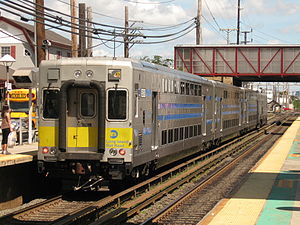| C3 | |
|---|---|
 C3 cab car #5019 trailing at Mineola | |
| In service | 1998–present |
| Manufacturer | Kawasaki[1] |
| Replaced | all C1 bi-levels, P72 and P75 single-levels |
| Constructed | 1997–1999 |
| Entered service | Fall 1998 |
| Number built |
|
| Fleet numbers |
|
| Capacity | |
| Operators | Long Island Rail Road |
| Lines served | |
| Specifications | |
| Car length | 85 ft (26,000 mm) |
| Width | 9 ft 10+1⁄2 in (3,010 mm) |
| Height | 14 ft 5.59 in (4,409 mm) |
| Maximum speed | 100 mph (161 km/h) |
| Weight |
|
| Power supply | 480 V 3-phase AC 60 Hz |
| Coupling system | Type H tightlock knuckle coupler |
| Track gauge | 4 ft 8+1⁄2 in (1,435 mm) standard gauge |
The C3 is a bi-level coach railroad car built by Kawasaki. Ordered by the Metropolitan Transportation Authority for use on the Long Island Rail Road (LIRR), the cars began to enter revenue service in 1997. The rail cars are pulled and pushed by EMD DE30AC and DM30AC dual-mode (diesel and electric) locomotives.[1] The C3 cars are powered by 480 V AC head-end power supplied from the locomotive.[2]
- ^ a b c "Long Island Rail Road Commuter Bi-Level". Kawasaki Rail Car Inc. Archived from the original on June 4, 2014. Retrieved August 1, 2011.
- ^ a b BI-LEVEL C-3 CARS Operator's Manual, Transit Documentation Consultants, January 2000